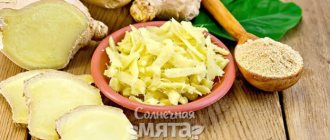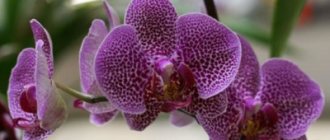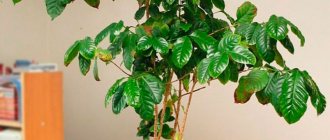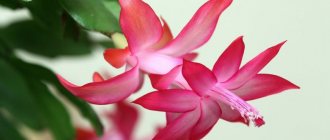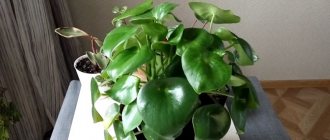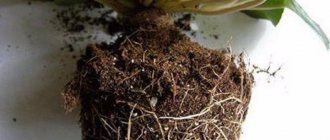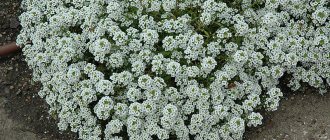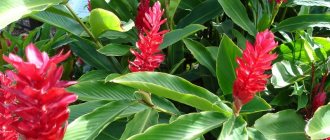Features of the plant
Ginger is a perennial herb. Belongs to the Ginger family and has 140 species. Translated from Sanskrit it means “horned root”, as it is called in the trading network. In fact, ginger, like any plant, has the following structure: root, stem, leaves, flowers, fruit.
Root
It represents a fibrous root system, consisting of a rhizome from which green above-ground shoots grow, cork tissue covering the rhizome with cells filled with yellow-green essential oil.
Stem
Round, without fluff, erect with internodes.
Leaves
Simple alternate with a rounded apex.
Flowers
Collected in spike-shaped inflorescences, consisting of five fused sepals.
Fetus
It is a three-leaf box.
Growing problems, diseases and pests
Ginger is considered a crop that is resistant to parasites and various diseases. When growing a plant, you may encounter a pest such as spider mites. It is recognized by the yellow specks on the foliage and the paleness of the stems. To make the web more visible, it is recommended to irrigate the crop.
How to get rid of spider mites:
- The plant should receive a lot of moisture and air humidification. The problem often occurs due to lack of drainage. The foliage should be periodically washed with water in the shower, wrapping the root system and flowerpot with a plastic bag.
- The most effective method of pest control is the use of insecticides. It is required to process the crop once a week. Sticks that are placed in a flowerpot do not act against ticks.
Important! If you eat the spice, it is better not to use insecticides, but simply wipe the leaves with alcohol.
Ginger helps cope with colds, adds a special taste to food, and its oil improves skin condition. A universal product is purchased in a store, but planting it yourself guarantees its high quality and environmental friendliness. Before growing, you need to know the rules for choosing roots and care, methods of propagation, how ginger grows, flowering time and what problems you may encounter.
Home care
When growing ginger at home, you must adhere to the basic rules of caring for it. What you need to know:
- Place the pot on the windowsill of the south window, but at the same time shade it a little with a curtain.
- Water moderately, without excess.
- Apply organic and mineral fertilizers in a timely manner.
- During wintering, do not water and keep cool.
Location and lighting
During the growth period, the plant can be located near windows in any direction, but in the south it is necessary to shade it from direct rays with curtains. In the north, he may not have enough light, then he will have to additionally provide artificial lighting.
In summer, a pot of ginger can be taken out into the garden or onto the balcony, placed in a place protected from direct rays of the sun and drafts.
Temperature
Ginger is a monsoon plant and goes dormant. To ensure its constant activity, you must adhere to the following temperature regime:
- in summer +20-25°C;
- in winter +18-20°С (not lower);
If the plant needs to create a dormant mode, then the temperature needs to be +10-15°C. When kept in rest mode, the temperature should be at least +12-14°C.
Watering
The intensity of watering ginger depends on the time of year and temperature.
In summer, abundant watering is necessary; the water should be settled and soft; filtered water can be used. In winter, at temperatures of +20°C and above, water after the top layer of soil has dried.
In dormant mode and in a cool room (+10-15 degrees), watering should be done only after the soil has dried. More often it is not recommended, the roots may rot.
Air humidity
Ginger prefers high humidity. During the growth period, regardless of the time of year, at temperatures above +20°C, it is useful to spray with soft, settled water.
The soil
The ginger mixture is best prepared from the following ingredients:
- 1:1:1:1 – humus, humus, sand, garden soil;
- 2:1:1:1 – greenhouse soil, peat, sand, rotted manure.
The components must be thoroughly mixed and placed in containers at least 25 cm high. You can use mixtures purchased in the store.
Feeding and fertilizers
During the growth period, when the root is formed, which, in turn, is a storage organ, it is necessary to apply fertilizer once every 10-15 days.
Ginger very well accepts organic fertilizers from mullein and bird droppings, which must be applied alternately, maintaining a proportion of 1:10 and 1:15, respectively. You need to be especially careful with bird droppings to avoid burning the roots.
During the initial growth period, you can water it with a urea solution. The growth of rhizomes is promoted by potassium sulfate at the rate of 50-60 g per 1 square meter. meter. There is no need to feed the plant in autumn and winter.
How to grow in the country
You can also grow ginger in the countryside. To do this, first germinate the root in a pot. The material is planted in winter closer to spring. They give you the opportunity to take root and shoot an arrow.
After the ginger has sprouted, it is transplanted to the garden plot. Before you figure out how to plant a root, pay attention to the rules for growing it in beds:
- Do not allow the soil to dry out.
- Ginger must be constantly sprinkled with warm water.
- The plant dies from direct sunlight, but needs a hot climate.
- The harvest is harvested in the fall, when the leaves have fallen apart and turned yellow. If the plant is grown as a flower, it is left to overwinter in the ground.
It is worth noting that not only the root, but also the leaves and stems are eaten.
Does ginger help you lose weight? Read this article.
Video No. 1 on how to properly plant ginger at home
Bloom
Much is known about the medicinal and culinary properties of ginger and almost everyone has heard about it, but very, very little is known about its flowering. In addition to common ginger, which is used as a medicinal and culinary product, there are a large number of varieties of ornamental ginger that have very beautiful flowers that are a unique sight.
Ginger flowers grow on long stems, and one inflorescence may contain petals of different shades.
All their beauty lies in their special structure, for example:
- Zerumbeta ginger produces rose-like flowers;
- Remarkable blooms powerful, corn-cob-shaped flowers of a bright pink hue;
- The Kasumunar variety has orchid-type flowers and is white in color.
Flowers appear after the second or third year of growth. Plants bloom for quite a long time.
What do ginger flowers look like?
A plant with a powerful straight stem looks like young bamboo, reed or sedge. Green shoots reach 1-1.5 m in height. The leaves are lanceolate, alternate, with a pointed end. The leaf plates, rolled into a dense tube, form pseudoshoots. The root system is fibrous: thin adventitious roots extend from a thick, horizontally located rhizome (modified underground shoot).
Blooming ginger amazes with its exotic appearance and variety of colors. The shape of the inflorescence depends on the variety: there are small spike-shaped and large single flowers, the corolla can look like a rose or a small cone. The color of the petals varies: from white and light yellow to blue and red-brown.
When the bud opens, it smells sweet and lemony. After flowering, a seed capsule is formed. Cultivated varieties do not have seeds; the plant is propagated by simple division.
Some species are dangerous for allergy sufferers. Purple ginger has special properties: thanks to its antihistamine effect, it can reduce the intensity of allergic attacks.
We also recommend reading:
Ginger - what it is and what it looks like Methods of planting ginger in open ground and care features What ginger looks like and what it is used for
Gardeners identify the most decorative varieties:
- Ginger Torch. The flowers look like oval-shaped balloons and are pale pink in color.
- Kasumunar. Delicate milky petals resemble an orchid.
- Zerumbet. A flower with dense, fleshy petals looks like a tea rose. The inflorescence collects an aromatic liquid that the Polynesians used as shampoo.
- Japonica is the northernmost of the ginger family. Flower buds are eaten and added to meat and vegetable dishes.
Reproduction
Ginger is propagated by dividing the rhizome (cultivated ginger does not produce seeds). The rhizome is cut into pieces with a sharp knife, each of which should have at least 2-3 buds. Prepared planting material to activate the buds can be placed in warm water for a while, then planted in shallow containers to a depth of 2-3 cm and placed in a warm room.
Before the first leaves appear, watering should be moderate and the humidity should be high. Soil composition with pH 5-6. To obtain healthy and suitable for growing seedlings, the rhizomes must be in the soil for at least 10 months.
Growing ginger
Ginger is grown in several ways, depending on its further purpose. They are grown in greenhouses and indoors for food consumption, and also to produce a flowering plant.
Growing in a greenhouse
There are two things you need to do first:
- Soil preparation - loosen to a depth of 30 cm. It should be loose, of medium acidity. Add humus, add 60 g per square meter of nitrophoska. It is advisable to create a drainage base from large pebbles or pine chips.
- Planting seedlings - rhizomes with shoots in April-May are planted in prepared and moistened soil in pre-made grooves about 20 cm deep. Seedlings are placed 30 cm apart. You can sprinkle humus on top.
Growing indoors
As with propagation, cut the ginger rhizome into pieces and plant it in a container. Flower pots, unnecessary pans, and other objects with a depth of at least 25 cm are suitable for this. Plant to a depth of no more than 3 cm. After about a month and a half, the first sprout will appear.
For everything to go smoothly, the following conditions must be met:
- create heat (+25-30°C);
- high humidity, spraying with soft water;
- provide moderate watering until leaves appear;
- Avoid exposure to direct sunlight.
For example, if ginger is planted in February, then in November you can harvest it by first stopping watering and waiting until the leaves and stems of the plant dry.
Cultivation to produce a flowering plant
Decorative varieties delight owners with beautiful colors. By the way, these flowers can also be used as medicine. In order to be able to contemplate the beauty of blooming ginger, you need to know and fulfill the following conditions:
- Water moderately, avoid excess moisture.
- Carry out mandatory spraying to create humidity.
- Apply fertilizers twice a month - potassium salt, superphosphate.
- In autumn, reduce watering and remove the plant to a dark place (basement).
- In the spring, change the soil and replant.
Blooms for approximately two weeks. With such agricultural technology, ginger grows almost everywhere.
Ginger is not grown in open ground in Russia, only in the southern regions as an annual plant.
Preparing to plant ginger
How to grow ginger - how to grow ginger at home
Before growing ginger at home, you need to know all the stages of the process. The most favorable time for planting a plant is February-March. If the requirements for lighting and temperature are met, ginger can be planted in any season. Before placing a flowerpot in the house, it is worth remembering that the birthplace of the culture is Asia. It should be a sunny and warm place; when it is hot, take the ginger to the balcony or veranda.
How to choose a root for planting
For cultivation, the plant is taken only fresh. You can also find ginger seeds on sale, but this is a time-consuming and expensive method. The root should be dense with vegetative buds and a thin peel. Ginger with visible fibers or a dry and wilted surface is not suitable for planting. The buds resemble potato sprouts.
Disinfection
Products in the store are often treated with a special mixture to prevent them from sprouting and to maintain integrity during transportation. Thoroughly wash off this layer or leave the ginger in water for a day. No less effective are antiseptic drugs: baking soda, phytosporin and potassium permanganate. Take 1 tsp per glass of water. any product and wash the root with the mixture.
Preparing the soil and pot
Before planting ginger, you need to choose the right container and soil. It is unpretentious, but requires a special substrate. It is recommended to prepare the soil yourself from leaf humus, sand and humus, which will fill the root with all useful components.
Self-planting spices in the country
They can bloom in a small container. If you plan to grow ginger to grow the root system, then it is better to choose a wide, but not deep, pot.
Important! When planting ginger in the ground, we must not forget about drainage and the presence of holes in the bottom to drain excess liquid.
Medicinal properties
Ginger is a universal medicine from ancient times. Almost cures all diseases.
- Contains ten antiviral compounds used in the treatment of viral infections.
- Medicines and tea – helps people suffering from diseases of the gastrointestinal tract, eliminates nausea and vomiting. Relieves symptoms of a cold.
- Powder - used in the treatment of inflamed joints, arthrosis, arthritis using lotions and compresses.
- Essential oil - to calm the nervous system, lower blood pressure, normalize blood composition, prevent blood clots, inhalation.
- Ginger oil is used to massage diseased areas of the body, drops are used to eliminate flatulence, indigestion, and cramps.
- Ginger is used as an antidote for seafood and fish poisoning.
- The use of the root is indicated for expelling parasites from the body.
- Promotes burning of subcutaneous fat during fasting diets.
- Ginger improves memory.
- Helps tighten and smooth the skin.
Kinds
This family contains more than 140 species. Ginger has long been relegated to the category of garden plants. Breeders have developed quite a few varieties, slightly different from each other in shade, roots, aroma, size and shape. All known varieties are defined in two groups:
- white - ginger from this group is more gentle, not bitter;
- black – has a sharp aroma and pungent taste.
The most common of all types is ginger officinalis.
Just one look at the ginger root arouses interest due to its shape, but there is no need to talk about its benefits - it is a treasure trove of useful substances that can support our immunity all year round. Therefore, the presence of this root in the house, along with onions and garlic, is mandatory. It is unpretentious in care and, having set the goal of growing it in your home, it will not be difficult to achieve results. All it takes is desire.
When does it usually bloom and how long does it bloom?
This tropical perennial grows and thrives year-round in plant hardiness zones 9b and above, but gardeners in more northern climates can grow ginger in a container. In its natural habitat, ginger blooms in the second year of its life. At home, when grown in a pot or greenhouse, ginger sometimes begins to bloom only in the third year. Ginger blooms in the second year only with proper care and when maintenance conditions are met.
The flowering period lasts several weeks. After its completion, it is better to cut off the peduncle. It is impossible to collect seeds from it. This is due to the fact that cultivated species do not produce seed material. As long as there is room in the pot for the root system to develop, you can continue to grow the plant. When it becomes too small, the root should be divided or transplanted into a larger container.
Ginger blooms from early to late spring, with a shorter interval from mid-morning to early afternoon, closed at night to conserve moisture. Flowers appear on short peduncles, collected in an inflorescence of spikes. The flowers are yellow-orange with purple-brown splashes.
Once planted, ginger takes about seven months minimum to develop a decent sized rhizome, so it needs a long growing season.
